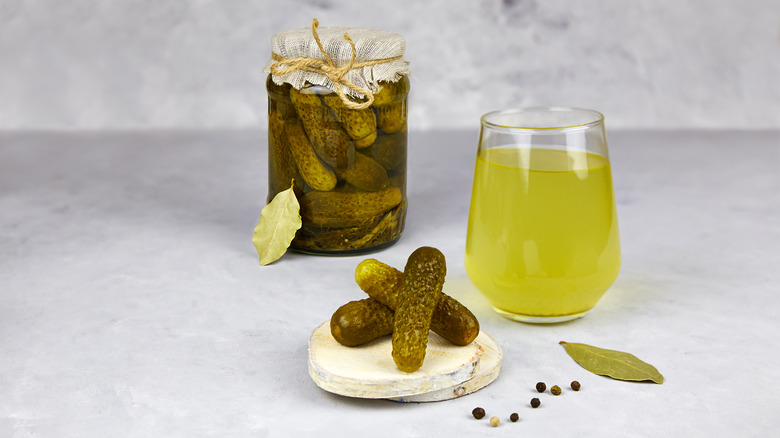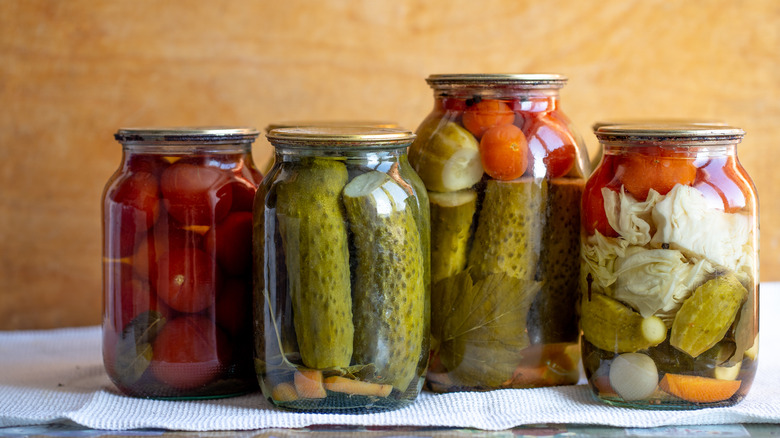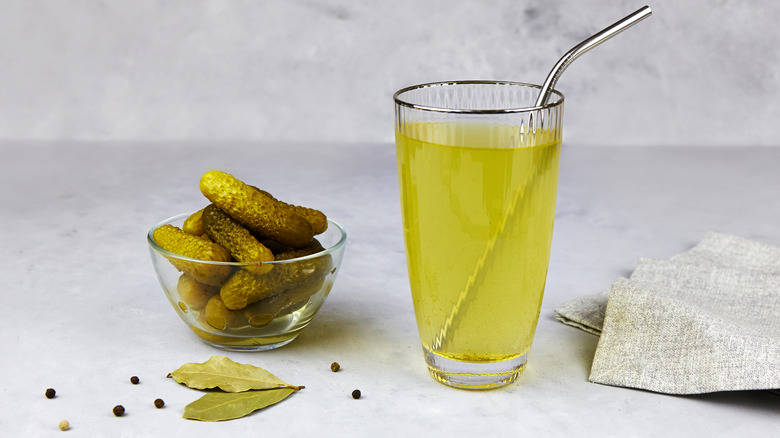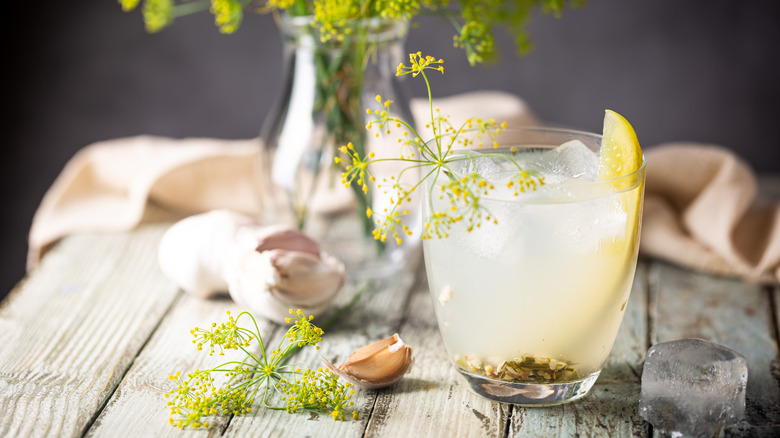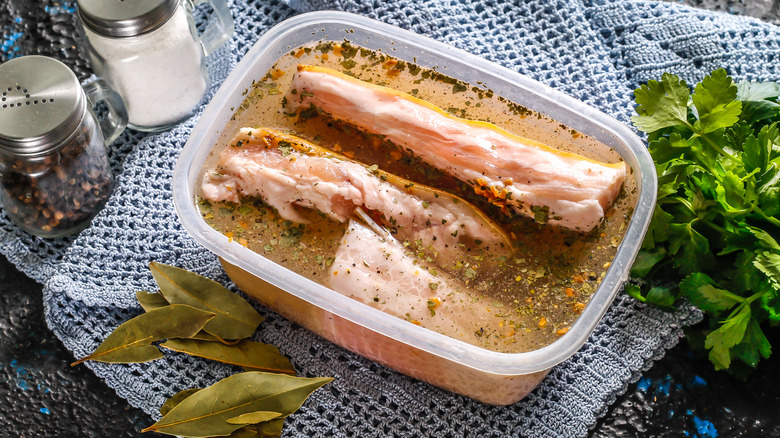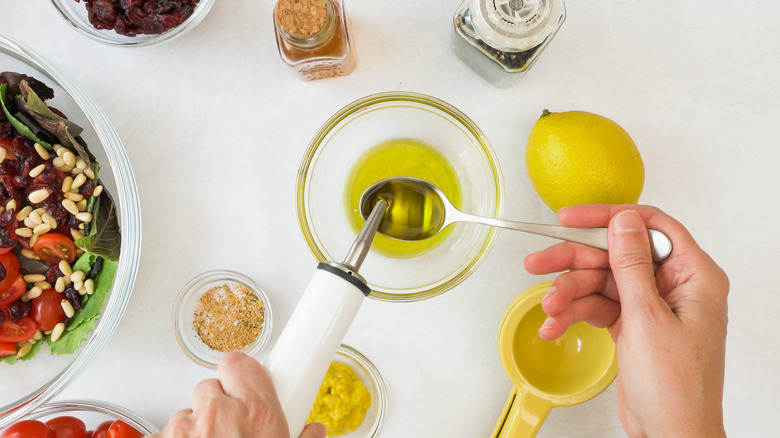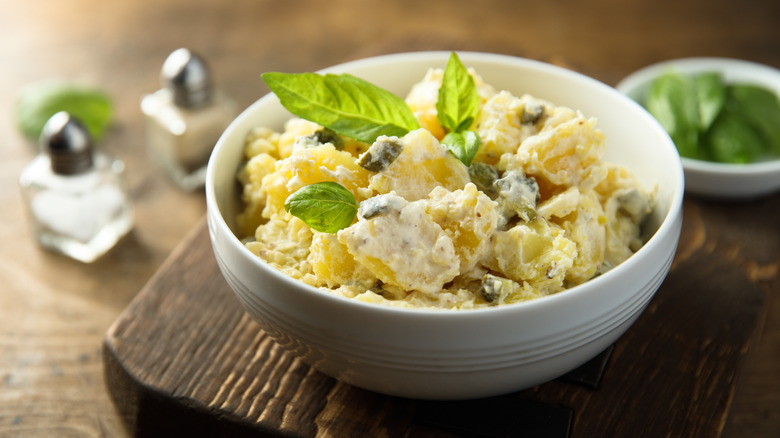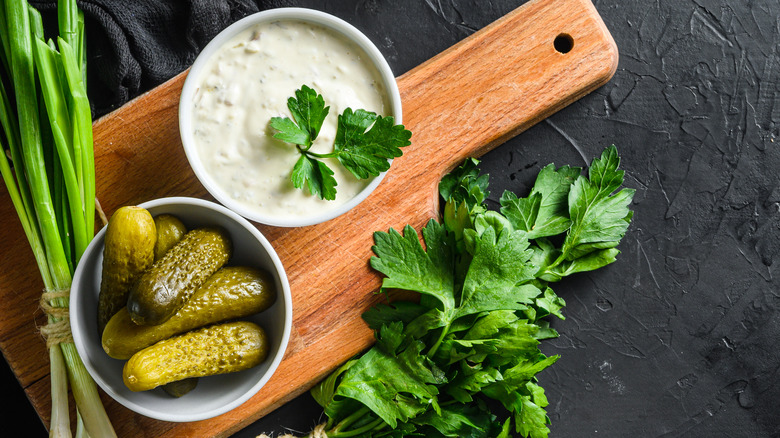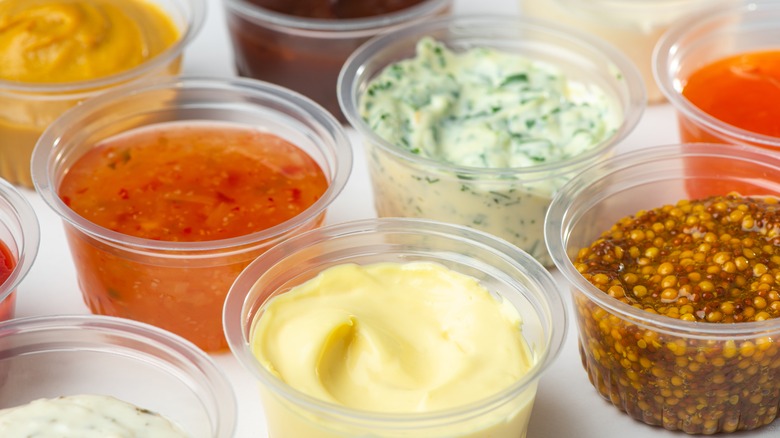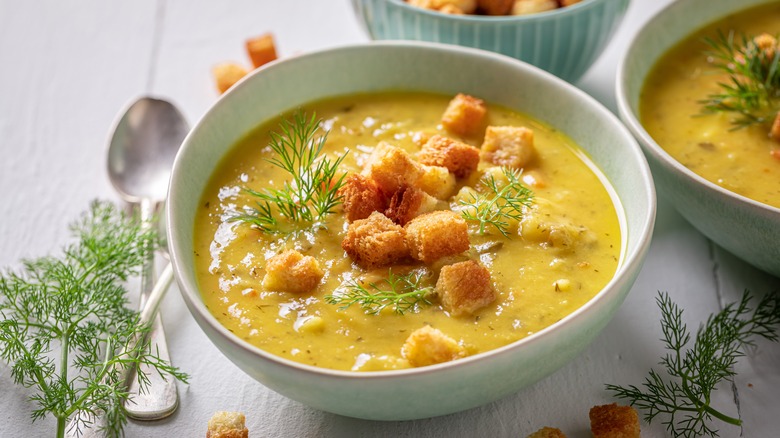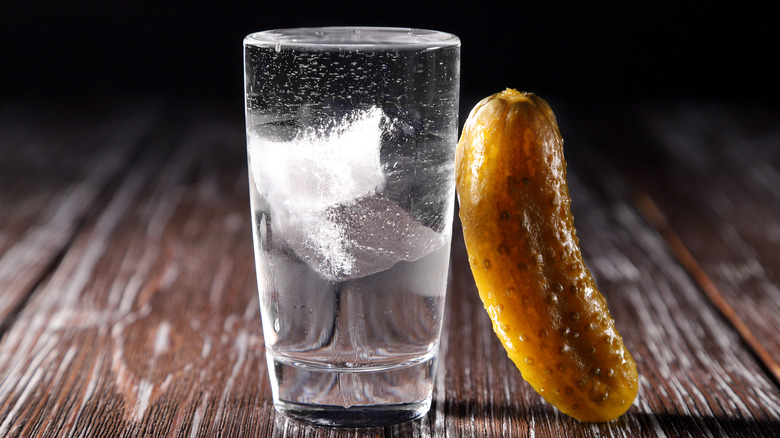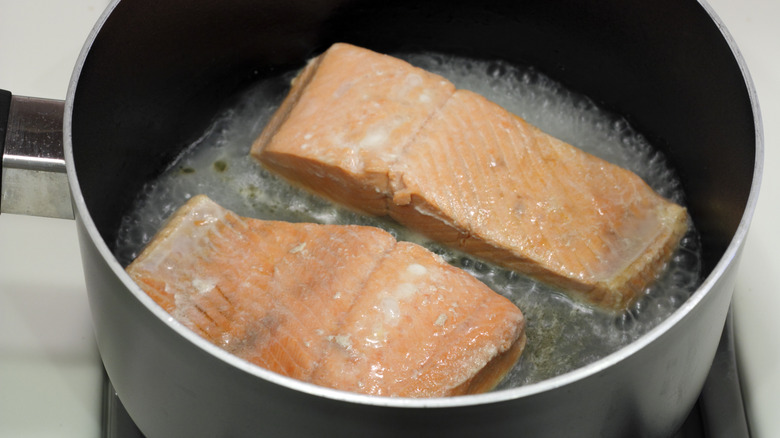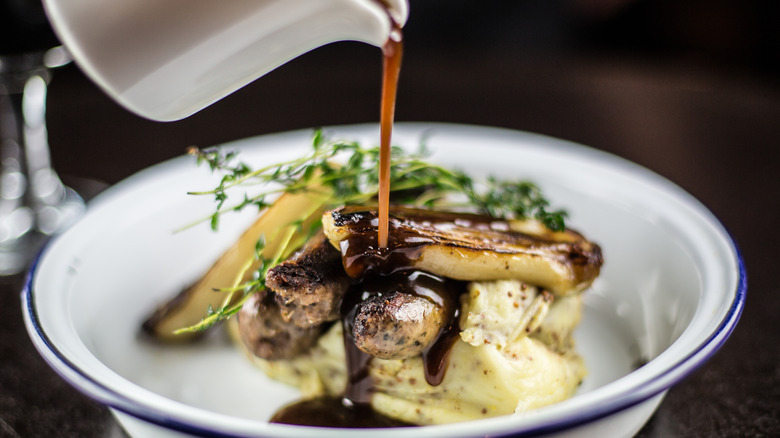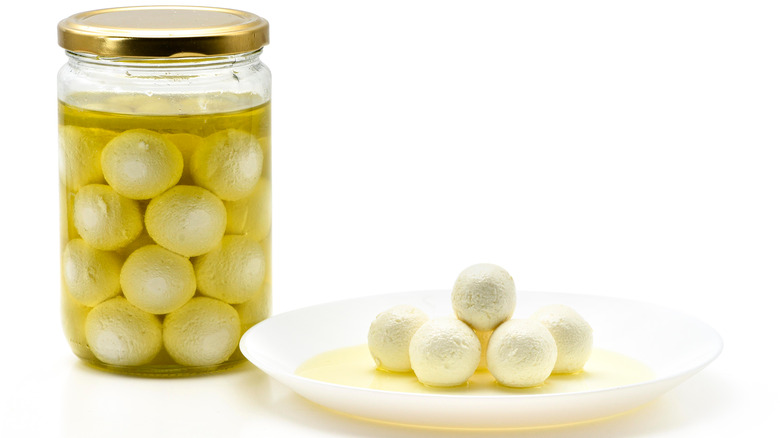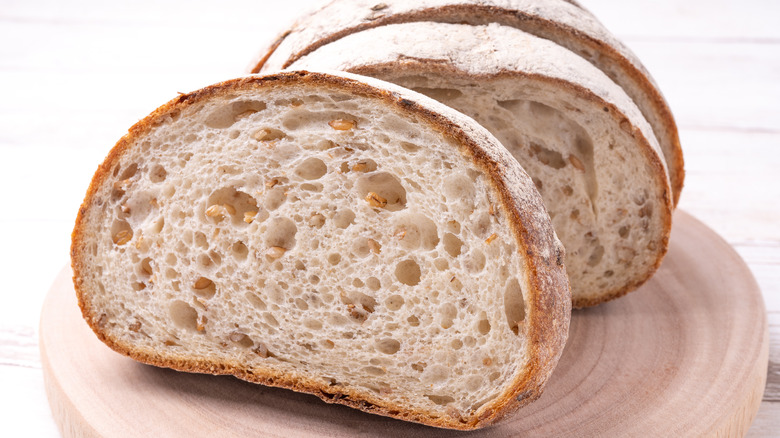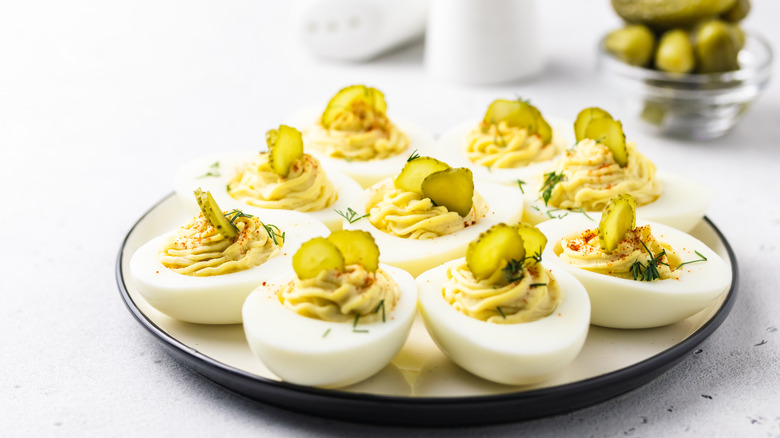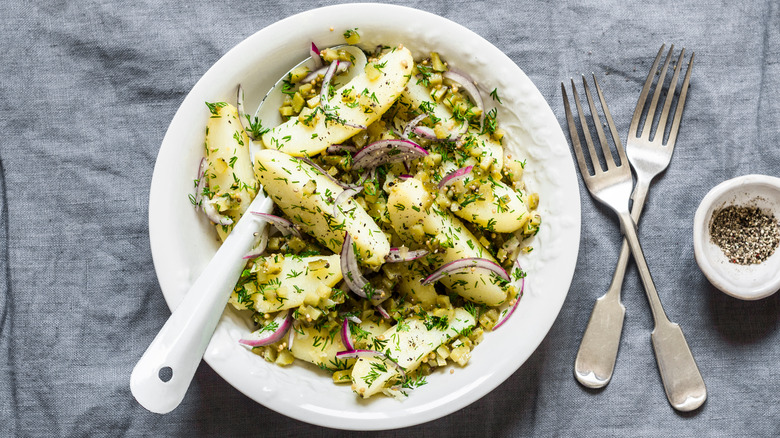16 Things You Can Do With Leftover Pickle Juice
Whether you make your own pickles or buy them from the store, you've most likely ended up with a jar of pickle juice after you've finished eating the pickles themselves. Chances are, you've dumped it down the sink or tossed the container away, brine and all. But don't be so quick to do that next time — as it turns out, that leftover liquid is packed with flavor and has more to offer than you might think.
Pickling has been around since ancient times as a preservation method. Submerging perishable food items in a salty or acidic solution protects them from spoilage. The main focus is typically on the pickles themselves, with the brine as a leftover, merely a result of the pickling process. But pickle juice can easily be repurposed and given a second life, with so many unconventional uses that you might just want to keep some on hand at all times.
Depending on the style of pickle, the juice can be tangy and vinegar-based, or it can be a salty brine from fermentation. Either type of juice can be sweet, savory, or salty, it can be loaded with umami, or it can be some combination of these, giving them endless culinary possibilities. Here are some applications for that leftover pickle juice.
1. Quick pickle more pickles with it
Since the main use of pickle juice is to, well, make pickles, it makes sense that you should use the leftovers to do the same thing, right? You can reuse pickling brine to make more pickles, but there are some guidelines to consider in order to get the most successful results, and most importantly, to make sure you're doing it safely.
The ratio of salt and acidity in pickling liquid is crucial to ensuring pickles don't spoil. That can present a problem with leftover juice. Vegetables and fruits contain water that can dilute the pickling liquid over time, so a used jar of brine may not be at levels strong enough to prevent potentially dangerous microbial growth. That's why it's safest to use leftover juice to make quick pickles, or refrigerator pickles, that aren't meant to be stored at room temperature or long-term.
You can easily toss some cleaned and chopped veggies or fruits in the same liquid and call it a day, but these are unlikely to develop much pickle flavor. For maximum effect, Cook's Illustrated recommends salting your food first, boiling the pickle juice, and then combining them and letting the new pickled ingredients develop for 24 hours. You'll get diminishing flavor returns if you continue using the same liquid — and an increased risk of contamination — so once your second batch is gone, it's best to let that juice go.
2. Drink it on its own
Some athletes swear by drinking pickle juice to relieve muscle cramps — in fact, a 2010 study published in Medicine & Science in Sports & Exercise found that drinking pickle juice shortened cramp duration about 45% more rapidly than water. The specifics of what makes pickle juice work in this regard are still unclear, but if you see someone chugging from a pickle jar at the gym, don't question it.
Aside from its cramp-reducing ability, pickle juice has other benefits as a beverage. It not only hydrates, but also replenishes sodium in the body, similar to the way sports drinks work but without the strange ingredients and high calories (although you will want to moderate your total sodium intake). Both dill and vinegar are two ingredients that some believe have medicinal properties, helping to improve gut health, so dill pickles in particular may give you an extra wellness boost.
And of course, there's the flavor. Not everyone is going to be jazzed sipping on a salty, tangy, sour beverage, but for those who love it, there's nothing quite like drinking pickle juice.
3. Make a cocktail with it
Savory cocktails are nothing new. The dirty martini has been around for over 100 years, although it was first made with muddled olives, and brine was a later addition. Still, the refreshingly salty, spirituous cocktail's popularity continues to endure, showing that people have a palate for unconventional, less sweet flavors in their alcoholic concoctions. Similar to olive brine, pickle juice packs a ton of tangy, herbaceous flavor in each drop, making it the perfect ingredient to include in cocktails when you're in the mood for something savory.
Replacing olive brine with pickle juice to make a different style of dirty martini, a dirty pickle if you will, is a great place to start experimenting with the flavor in your cocktails. It's also right at home in a bloody mary, adding a bright salinity and tang to the iconic brunch beverage. It mixes well with lots of spirits, punching up the vegetal notes in tequila, matching the spices and herbs in gin, and showcasing itself unadorned with neutral vodka. While it's not technically a cocktail, per se, the pickleback is a well-established pairing, consisting of a shot of whiskey or other liquor followed by a chaser of pickle juice. You may be surprised at how well pickle juice complements such a wide variety of flavors.
4. Use it as a marinade
With its combination of salt, acidity, and aromatics, pickle juice makes the perfect marinade for meat, seafood, tofu, or really anything else you want to pump full of seasoning and flavor. There's no preparation required, since it's sitting in a jar ready to go, and there's no need to come up with a specialized marinade recipe, since pickle brine goes with everything. Just a few hours swimming in the stuff (less, if you're marinating fish or shellfish) is all it takes to add a big punch of flavor.
Pickle juice is one of our favorite marinades for fried chicken. Acidity from the vinegar works to break down the chicken's protein molecules, so you'll end up with succulently tender meat. That makes it the perfect foil for fried chicken's crispy exterior, while the zesty pickle flavor lightens up a typically heavy dish.
Chicken and pickle brine are a perfect match, but don't stop there. A pork chop, which has a tendency to dry out, is kept tender and juicy thanks to a pickle marinade. If you've got spicy pickle juice with lots of pepper and chili flavor, use it with a skirt or flank steak. Pickle-brined shrimp are a sweet, salty seafood delight. Tofu marinated in pickle juice, then breaded and fried, makes for a great vegetarian sandwich filling.
5. Make a vinaigrette with it
If you're looking for a reason to eat more salad, here's an easy way to bump up the excitement: Use leftover pickle juice to make a vinaigrette. Instead of just plain vinegar, or in addition to it if you want extra tang, whisking pickle juice into vinaigrettes brings not just acidity, but also layers of seasoning and spice. There's hardly an easier way to liven up a bowl of greens.
A basic vinaigrette recipe calls for oil, acid — typically either citrus or vinegar — along with salt, pepper, and flavorings like mustard and herbs. If you're substituting pickle juice as the acid component, make sure you are adjusting the other seasonings, since it already includes salt and aromatics. Garlic and dill-infused pickle juice makes a refreshing and zippy dressing, while pickled beet juice adds a satisfying earthy quality. The leftover brine from kimchi makes a hot and spicy vinaigrette. Play around with different types of pickle juice, and match them to the ingredients you're using for maximum flavor effect.
6. Add it to chicken, potato, or tuna salad
You don't want to be the person who brings a bland salad to the cookout. Whether you're making a chicken, potato, or tuna salad, or another picnic dish in a similar vein, you can ensure it's seasoned and flavorful by adding pickle juice as your secret ingredient. Instead of having to gather dozens of items to flavor your dressing, pickle juice adds salt, spice, tang, and herbal zest in one humble liquid.
Whether you are mixing your salad with a mayo or oil-based dressing, pickle juice can be easily whisked in to give it extra dimensions of flavor. Dill and garlic have a natural affinity for tuna, chicken, and potatoes, and you can always add more fresh herbs and other spices to the dressing to punch up the flavors you want to boost to the forefront. Make sure you adjust any added salt in order to avoid over seasoning, since pickle juice can add a substantial amount.
7. Make a pickle-flavored dip
Imagine it's game day, and you've got a table full of chips — but nothing to dip them in. Don't fret because pickle juice is there to come to the rescue. You can put together a bright, peppy dip in just a few moments by swirling pickle juice into sour cream, mayonnaise, yogurt, or any combination of the three. Pickle dip is not just for chips. It is also delicious with chopped vegetables, crackers, breadsticks, and more.
If you've got a little more time to plan, you can make your pickle dip even more flavorful by adding ingredients to further boost flavor and texture. Chopping up pickles, if you've got some left in the jar, and stirring them into the dip, will make it extra pickle-flavored and add crunchy texture. Spice up your dip with a few drizzles of hot sauce or dried chile flakes or powder. Citrus juice or zest amp up the tanginess. If you've got fresh herbs on hand, like dill, parsley, and chives, chop them up and mix them in or add on top as a bright green garnish.
8. Mix into condiments
Pickle juice can be stirred in to so many things. There's really no limit, and the world of condiments is no exception. Most condiments include an acidic element, and pickle juice can be used in place of citrus or vinegar if you're making them from scratch. It can also be swirled into store-bought condiments to add extra seasoning and flavor. Rather than mixing in relish, using pickle juice gives you that distinct pickle flavor without altering the condiment's texture.
The big three — mayonnaise, mustard, and ketchup — all work beautifully with a boost of pickle flavor. The acidity boosts each condiment's tanginess while adding spice. The liquid will change the condiment's consistency by thinning it out, so depending on what you're using it for, keep that in mind, or you could end up with a spread that's too watery. Different styles of pickle juice are great for shifting the flavor profile of these condiments — you can mellow out an overly spicy mustard with some sweet pickle juice, or amp up the heat of a fruity ketchup with a particularly spicy brine.
9. Add it to soups and stews
There's nothing more satisfying than the smells that fill your house when you're making a long-simmering soup or stew. But sometimes, once it hits your palate, the taste is underwhelming. That's where pickle juice comes in. If you've got a jar of pickles in the fridge, a splash of brine stirred into an inadequately seasoned soup, stew, or chili can give it just the jolt it needs, with minimal added effort.
Pickle flavor is such a good companion with soup that it's actually got its own recipe: pickle soup. Known as zupa ogórkowa in its native Poland, this soup includes pickles and pickle brine and is a true love letter to the ingredient. All pickle fans should make it at least once in their life, but until then, use a few glugs of pickle juice to jazz up everything from Classic Chicken Noodle Soup to Southwest Chili.
10. Make pickle ice cubes
Pickle juice takes on an even more refreshing character when it's ice cold. You can have an invigorating burst of arctic pickle flavor on hand whenever you'd like by making a tray of frozen pickle juice ice cubes. These frosty nuggets are perfect to add to savory drinks like bloody marys, gin and tonics, or even just water if you want to add a dash of briny flavor.
Plain pickle juice makes tasty ice cubes on its own, but you can create visually stunning ones by including solid ingredients that will freeze suspended inside of the cubes. Sprigs of dill, parsley leaves, or small chopped chives add bright green color and hints of fresh herb aromas as they melt. Pickling spices like mustard seeds and peppercorns look pretty and add more intense flavor as they emerge from the dissolving cubes.
Solid items like herbs and spices tend to either sink to the bottom or float to the top of cubes as they freeze. One technique to keep them in the middle is to fill the tray halfway and freeze it. If the items have floated, fill the rest of the tray, freeze again, and they'll stay in the middle. If they've sunk, flip the cubes before topping off the tray with more juice.
11. Add it to poaching or steaming liquid
The next time you are poaching or steaming your dinner, add pickle juice to the pot for a boost of flavor. Water, wine, or stock will all benefit from a shot of pickle goodness. More subtle than a long-term marinade or a full-flavored condiment or sauce, just a few spoonfuls of pickle juice added to your poaching liquid will give your food a delicate hint of aromatics and seasoning. Even the most mild flavored fish or vegetable won't be knocked over by pickle flavor if you use these methods. But they will instead take on a mellow salinity and gentle spice.
Many recipes for poached eggs call for adding vinegar to the water to help the egg whites form and better hold their shape. Instead, opt for pickle juice, which thanks to its acidity, will give you the same practical effect as pure vinegar while also throwing in a little bit of extra flavor and seasoning.
12. Stir it into sauces
In much the same way that you can use pickle juice to add seasoning to condiments, salad dressings, and soups, you can also inject a shot of flavor by adding it into all kinds of sauces. With any sauce that includes an acidic component, you can substitute pickle juice instead. Try it in place of vinegar in homemade barbecue sauce, or stirred into store-bought sauce. You'll notice its distinct briny tang adds a pickle bite that's complementary to both sweet molasses and mustard-based sauces.
Give your gravy extra punch by swirling in some pickle juice. Whether it's Thanksgiving turkey or country-style sausage gravy, a little pop of pickle juice adds dimension, cuts through richness, and can be used to thin out gravy that's gotten too thick. If you make your own hot sauce, next time use pickle juice instead of vinegar — as a bonus, if the brine is from spicy pickles, it'll add even more heat.
13. Make pickle-marinated cheese
This might be one of the easiest uses for leftover pickle juice. No need to empty the jar or strain the solids out– once the last pickle is gone, just add cheese to the juice. After a nice long soak in the pickling liquid, your cheese will be imbued with fresh, briny pickle flavor and ready to be snacked on, cooked with, and added to salads (throw the cheese on a salad tossed with pickle juice vinaigrette for a double dose of pickle goodness).
Young, fresh cheeses like mozzarella and feta work best — they sometimes already come packed in brine. Halloumi and paneer cheese are good options, too. You want a cheese that's fairly neutral and has some decent firmness so it'll keep its shape. If you have a creamy cheese, like a whipped feta or soft chevre, instead of adding the cheese to the brine — which could cause it to disintegrate — add some brine to the cheese and blend it in until it's completely combined. Super tangy, salty, and flavorful pickle-marinated cheese is a fantastic addition to a charcuterie board.
14. Add it to homemade bread
Adding pickle juice to homemade bread is not as unusual as some may think. It's a common ingredient in Jewish rye bread and adds just a touch of sourness that complements the dill, caraway, and mustard seeds speckled throughout the loaf. So if you've enjoyed a sandwich on rye, like a classic Reuben at a traditional deli, you've likely tasted bread with pickle juice. But this ingredient needn't be contained to just rye bread. You can add it as a flavoring to all kinds of homemade bread doughs to given them that special pop of pickle flavor.
This recipe for Pickle Juice Bread shows you an easy way to add it: Simply replace the water you use to proof the yeast with pickle juice that's warmed to the proper temperature (and add sugar to help the yeast activate). Be aware that salt and vinegar can act as yeast inhibitors (in fact, too much vinegar can actually kill your yeast), so with the addition of pickle juice, your bread may take longer to rise, and you might want to adjust other ingredients accordingly. It make take even experienced bakers a few tries to get it right, but it's worth it to have pickle juice bread on your hands — perfect for sandwiches that, of course, feature pickles.
15. Add it to deviled egg filling
If you've ever served deviled eggs at a party, you know how fast they can disappear. This classic festive snack has been popular for ages, and with good reason — each egg is a creamy, salty little bite that's easy to eat with one hand while you hold a drink with the other — a pickle martini, perhaps? Since deviled eggs are rather labor-intensive, for the deviled egg chef, it can be demoralizing to see the hours of work gone in an instant. So here's one easy shortcut to shave some time off of their preparation: Use pickle brine to season the filling.
Rather than futzing around with shelves of individual spices, a few glugs of pickle juice can be all you need to perfectly and fully season your eggs. Since it's briny, you may not even need to add salt. The liquid also gives the egg filling a light, smooth texture. It may not make the boiling and peeling any easier, but you'll know your eggs will be packed full of flavor with just one ingredient. Since the pickle flavor will be quite pronounced, make sure to seek out the highest quality pickles and avoid any subpar pickle brands that might ruin your eggs.
16. Boil potatoes in it
Potatoes are one of the great "blank canvas" foods — they work with just about any flavoring, seasoning, and cuisine you can throw them into. Spuds of all varieties have a particular affinity for certain flavors like dill and garlic, and a burst of acidity is always a welcome addition to offset the richness and creaminess that potatoes bring to the table. Put those pieces together and you'll see that potatoes and pickle juice are practically made for one another.
The easiest way to incorporate pickle flavor into your potato dishes is to add the briny juice to the pot of water before you boil them. Depending on how strong you want the flavor to be, you can add as little or as much brine as you'd like. The result is salty, tangy, herbaceous spuds that you can then use in whatever recipe you like: Mash them, roast them, fry them, or toss them in dressing to make an extra pickle-forward potato salad. However you prepare them, you'll be able to knock out both your pickle craving and carb craving in one fell swoop.
